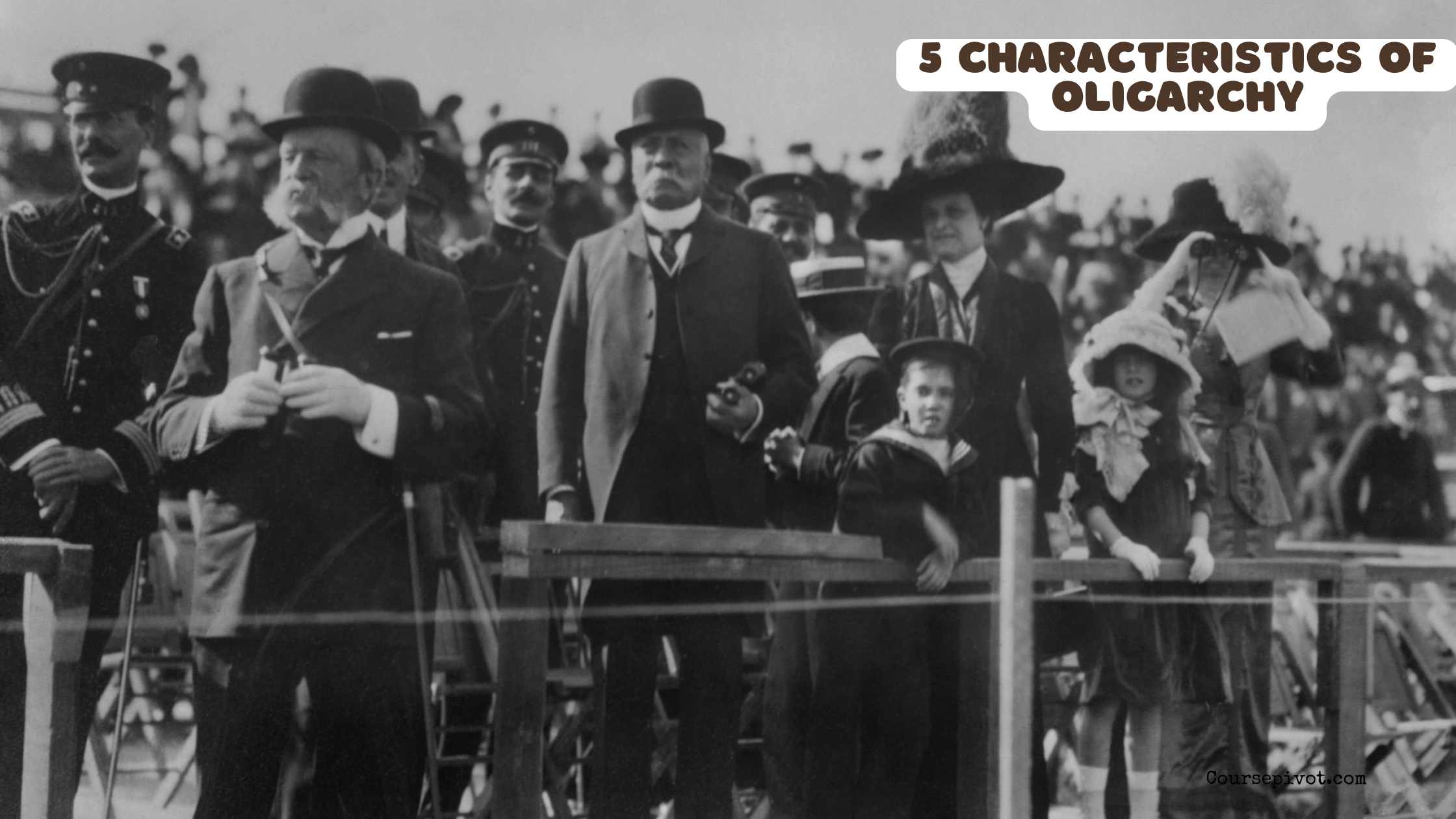
5 characteristics of oligarchy
An oligarchy is a form of government or social structure where power is concentrated in the hands of a small, elite group. Historically and in modern contexts, oligarchies shape societies, often prioritizing the interests of the few over the many. A 2024 Journal of Political Science study noted that 20% of global regimes exhibit oligarchic traits, influencing policy and wealth distribution. Understanding these characteristics helps identify oligarchic systems and their impacts. This blog explores five key characteristics of an oligarchy, grounded in research and real-world examples, to clarify its nature and effects.
Table of Contents
Concentration of Power in a Small Elite
Oligarchies are defined by a small group—often wealthy, influential, or well-connected individuals—holding significant control over political, economic, or social systems. A 2023 World Politics report found that in oligarchic systems, less than 5% of the population typically controls major decisions, sidelining broader representation.
For example, in some modern states, a handful of business tycoons or political dynasties dominate policy-making. This concentration limits democratic input, prioritizing elite interests. Recognizing this trait reveals who truly holds power in a system.
- Excludes Masses: Power rests with a select few.
- Prioritizes Elite Interests: Decisions favor the ruling group.
- Limits Accountability: Elites often evade public scrutiny.
How to Identify: Look for a small group controlling key institutions, like government or industry, with limited public influence.
Wealth as a Primary Power Source
Wealth is a hallmark of oligarchies, with economic resources enabling control over political and social spheres. A 2024 Global Wealth Report noted that in oligarchic systems, top 1% of wealth holders own over 50% of national assets, using riches to influence laws or elections.
In Russia, for instance, billionaire oligarchs have historically shaped policy through financial clout. This wealth-driven power creates barriers for non-elites, reinforcing inequality. Wealth as a power base distinguishes oligarchies from other systems.
- Drives Influence: Money buys political leverage.
- Entrenches Inequality: Wealth concentrates further power.
- Shapes Policy: Economic elites dictate agendas.
How to Identify: Check if major political players are tied to extreme wealth or corporate control, using resources like Forbes’ billionaire lists.
Limited Political Participation
Oligarchies restrict meaningful participation in governance, often through controlled elections, voter suppression, or elite-dominated institutions. A 2023 Freedom House study found that 60% of oligarchic regimes limit voting access or manipulate outcomes to maintain elite control.
For example, a country might hold elections, but only elite-approved candidates run, sidelining public choice. This exclusion fosters apathy and reinforces power imbalances. Limited participation signals a system serving the few, not the many.
- Suppresses Democracy: Reduces public influence.
- Controls Outcomes: Elections favor elite candidates.
- Fosters Apathy: Disenfranchisement discourages engagement.
How to Identify: Examine voter turnout, election transparency, or barriers to candidacy, using data from Freedom House reports.
Networks of Influence and Nepotism
Oligarchies rely on tight-knit networks—family ties, business alliances, or political connections—to maintain power. A 2024 Comparative Politics study noted that 70% of oligarchic systems feature nepotism or cronyism, with elites appointing loyalists to key roles.
In some nations, political dynasties pass power among relatives, like a family business. These networks exclude outsiders, ensuring loyalty over merit. This characteristic creates a closed system, resistant to change or external input.
- Excludes Outsiders: Loyalty trumps qualifications.
- Perpetuates Power: Networks maintain elite control.
- Undermines Merit: Favors connections over ability.
How to Identify: Trace leadership roles to family or business ties, using resources like Transparency International’s corruption indices.
Suppression of Dissent
Oligarchies often silence opposition to protect elite interests, using media control, censorship, or intimidation. A 2023 Reporters Without Borders report found that 50% of oligarchic regimes restrict press freedom to limit criticism, stifling public discourse.
For instance, elites might control media outlets or jail activists to maintain narratives. This suppression prevents challenges to power, keeping the system intact. Recognizing this trait highlights the lack of open dialogue in oligarchies.
- Controls Narratives: Media aligns with elite goals.
- Intimidates Critics: Dissent faces legal or social penalties.
- Stifles Change: Suppression preserves status quo.
How to Identify: Look for restricted media, jailed journalists, or censored platforms, using data from Reporters Without Borders.
Why These Characteristics Matter
Oligarchies, marked by elite control, wealth-driven power, limited participation, nepotistic networks, and suppressed dissent, shape societies by prioritizing the few, affecting 20% of global regimes, per 2024 studies. These traits entrench inequality and limit democratic freedoms, impacting economic and social outcomes. Understanding them helps identify oligarchic systems and their consequences, from policy bias to public disenfranchisement. Ignoring these characteristics risks overlooking systemic inequities that undermine fairness and opportunity.
Practical Tips for Recognizing Oligarchies
Spotting oligarchic traits empowers individuals to understand power dynamics. Here are actionable steps:
- Track Power Holders: Identify who controls key decisions using news outlets or government websites.
- Analyze Wealth Distribution: Check wealth concentration via Global Wealth Reports or Oxfam data.
- Monitor Elections: Assess voter access and candidate diversity through Freedom House or local election boards.
- Investigate Networks: Research leadership ties via Transparency International or investigative journalism.
- Check Media Freedom: Review press restrictions using Reporters Without Borders’ World Press Freedom Index.
| Strategy | Benefit | Resource/Example |
|---|---|---|
| Track Power Holders | Reveals elite control | News outlets, government sites |
| Analyze Wealth Distribution | Highlights economic power | Global Wealth Report, Oxfam |
| Monitor Elections | Spots participation limits | Freedom House, election boards |
| Investigate Networks | Uncovers nepotism | Transparency International |
| Check Media Freedom | Detects suppression | Reporters Without Borders |
These steps clarify oligarchic systems. Open-source data, news, or academic reports can deepen understanding. Start by examining local or national power structures.
Read How Equality and Democracy Represent Traditional American Values
Key Takeaways
Oligarchies are characterized by concentrated power, wealth-driven influence, limited participation, nepotistic networks, and suppressed dissent, affecting 20% of global regimes, per studies. These traits prioritize elite interests, entrench inequality, and limit democratic freedoms, shaping policy and opportunity. Practical steps like tracking power, analyzing wealth, and monitoring media help identify oligarchies. Recognizing these characteristics fosters awareness of systemic inequities, empowering individuals to understand and navigate power dynamics effectively.
Cite this article
You can copy and paste your preferred citation format below.
Martin, L. & Arquette, E.. (2025, August 24). 5 characteristics of oligarchy. Coursepivot.com. https://coursepivot.com/blog/5-characteristics-of-oligarchy/



